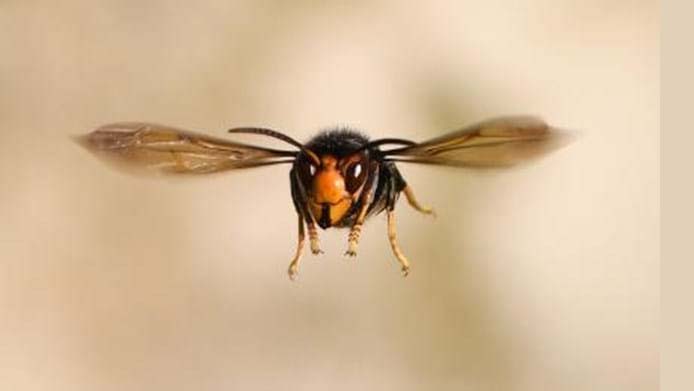What are Asian giant hornets?
Asian giant hornets are the largest hornet species in the world, native to Asian countries such as South Korea, Japan and Taiwan. These hornets are aggressive predators and will hunt medium- to large-sized insects such as other hornet species, large beetles and mantises. However, they’re especially known for feeding on honey bees and have the capability to quickly decimate local populations that they come into contact with. While Asian giant hornets do not generally attack people or pets unprompted, they can if threatened and are able to sting repeatedly. Their stinger is longer and more dangerous than that of most other stinging insects, containing neurotoxins and capable of puncturing a beekeeping suit.
What do Asian giant hornets look like?
Asian giant hornet size usually ranges between 1.5 to 2 inches in length, while queens can exceed that. Their stinger is about ¼ inch long and they have a 3 inch wingspan. Perhaps most notably, this species has a large orange-yellow head with prominent eyes and sharp mandibles. Additionally, their abdomen is covered in dark brown and yellow stripes. Because of their appearance, people may mistake bald-faced hornets or European hornets for them.
Typically living underground, an Asian giant hornet nest can be difficult to locate or see. This species will dig into the ground to create nests or even occupy pre-existing tunnels dug by other creatures like rodents. These hornets will also seek out areas near rotted tree roots.
Why are they sometimes referred to as “murder hornets”?
Media reports and social media posts have referred to Asian giant hornets as “murder hornets” in certain instances. While this species is known to kill as many as 50 people a year in Japan, their dubious nickname comes from their aggressive and deadly behavior towards honey bees, rather than humans. In fact, Asian giant hornets can attack and destroy entire honey bee hives in a matter of hours.
When these hornets come upon a honey bee hive, they will use their sharp mandibles to decapitate and kill the bees. In what is referred to as the “slaughter phase,” Asian giant hornets can kill up to 40 honey bees per minute, allowing a minimal number of hornets to destroy an entire colony in as little as 90 minutes. Although honey bees may try to fight back and sting their attackers, Asian giant hornets are armored and much larger than them. After the a honey bee colony has been destroyed, the hornets will eat the hive’s larvae and pupae, and also feed it to their own offspring. If these hornets become established in an area, they can considerably affect local honey bee populations.
Have Asian giant hornets been found in America?
While typically only found in Asian countries, the first confirmed U.S. sightings of this hornet species occurred in Washington state during December 2019. At the moment, there have not been any confirmed encounters with Asian giant hornets in any other U.S. state and Washington state officials are actively working to prevent any migration or population growth. However, because of their similarities in appearance, people can confuse or misidentify bald-faced hornets or European hornets as Asian giant hornets.
Should I be worried about Asian giant hornets?
The Asian giant hornet is not known to be established in the United States, so it is extremely unlikely that anyone outside of Washington state will encounter these hornets. If in fact these hornets become an established invasive species in America, they have the potential to negatively impact local environments and public health.
However, at the moment, Americans face much more risk from common stinging insects like wasps and yellowjackets. In fact, these pests send over 500,000 people to the emergency room each year. Species such as the bald-faced hornet can be found throughout the U.S. and can sting repeatedly due to their smooth stingers. Bald-faced hornets are aggressive and are known to attack anyone or anything that invades their space, unlike other stinging insects that only sting when they feel extremely threatened.
How can I prevent a stinging insect infestation?
- Keep trashcans covered and sealed
- When dining outside, keep food covered until ready to eat
- Avoid wearing sweet-smelling perfumes or colognes when going outside for long periods of time
- Ensure all doors and windows are properly screened, and seal any cracks or crevices along the exterior of the home
- If you are approached by a stinging insect or inadvertently find yourself near an active nest, remain calm and quiet. Slowly walk away from the area and avoid swaying or swinging, as this may provoke an attack.
What should I do if I’m stung?
- Remove the stinger as quickly as possible to decrease the amount of venom released
- Clean the affected area with soap and cold water, using cold compressions to reduce swelling
- If you or someone else experiences symptoms of an allergic reaction, such as throat or tongue swelling, dizziness or shortness of breath, call for emergency medical assistance
What should I do if I discover a nest?
Removing a stinging insect nest is not a “do-it-yourself” job. Attempts to remove a nest will disturb and threaten these pests, causing them to attack, sometimes in large numbers. If you discover a nest on your property, contact a pest control professional for help. Licensed professionals have the proper equipment and knowledge to effectively and safely handle an infestation.
For any suspected Asian giant hornet encounters outside of Washington state, the Washington State Department of Agriculture recommends people contact their state’s department of agriculture immediately.
Photo Credits: Getty Images


Leave a Reply